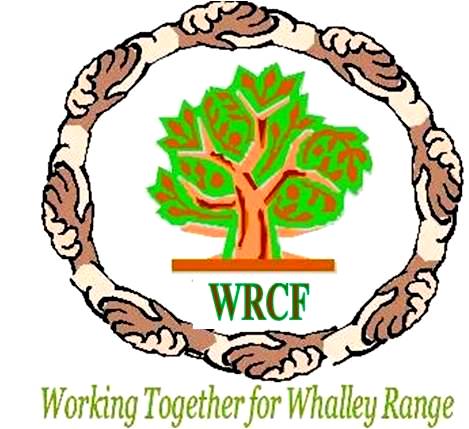Category: Whalley Range Community Forum



The Whalley Range Community Forum (WRCF) is a voluntary representative residents group formed in 1995 to facilitate and improve communication between members of the community and those who serve/represent Whalley Range.
The Forum act as an umbrella organisation, bringing residents and local services together to address local issues, to promote consultation and community cohesion – and to encourage participation.
The Forum produces a bimonthly newsletter and residents meetings to address local concerns with Police, Councillors, local council and planning officials, sends out a regular email bulletins featuring opportunities, events and news to around 400 residents from Whalley Range – and co-facilitates an annual local community festival.
The Forum worker supports new and emerging groups to access funding to set up their own community groups, holds funds for unconstituted groups and addresses resident priorities by facilitating relevant classes at the JNR8 centre during school term times.
Classes and initiatives for the diverse local community include mixed and women-only ESOL classes, women fitness, Tai Chi, confidence building sessions, basic computer and work club support and art and wellbeing classes and afternoon tea for older residents. JNR8 is also registered as a Third Party Hate Crime Reporting Centre.
The community website features local news and events, consultation links, age-friendly news and current vacancies and opportunities.
Follow @WhalleyRangeorg and @AgeFriendlyWR on Twitter
JNR8 Youth & Community Centre, 82 Cromwell Avenue, Whalley Range, M16 0BG
Tel: 0161 881 3744 | Email: communityforumwhalleyrange@gmail.com agefriendlywhalleyrange@gmail.com
Scottish Country Dance Classes in Whalley Range!
ManchesterFlyer_ChorltonHigh_Sept2019_Rev0

Join the Whalley Range Scouts!
Hi!
We thought we’d let you know that we’ll have spaces for new Beavers, Cubs and Scouts to join 123rd Manchester Scout Group this September. We’re open to girls and boys aged from 6-14years and offer a varied program of activities to offer something for everyone.
We’re based on Alexandra Road South in Whalley Range and meet on Monday Evenings at 5:45pm in term time.
Interested parents can contact Jonny on 07825 836 415 or email manchester123scouts@gmail.com
Lotte Karlsen solo exhibition ‘Sound of Silence’ in New York Next Month
Shimmering Sound of Silence travels across the Atlantic
On Thursday 8 September, Norwegian Artist, Lotte Karlsen will officially open her solo exhibition ‘Sound of Silence’ in West Chelsea Art studios, New York City, as the final installment of an arts programme connecting female artists across the Atlantic.

Highlights:
- Manchester (UK) based collective, Alexandra Arts, celebrates the final installment of Pankhurst in the Park 2016 arts programme in New York City.
- The solo show entitled ‘Sound of Silence’ will showcase a glass installation – involving 241 crystals – by Norwegian artist, Lotte Karlsen.
- The pop-up exhibition will launch on Thursday 8 September 6-8pm at Studio 511,West Chelsea Arts Building, West 26th St. New York, NY, and runs until 24 September.
- The exhibition will be housed inside a small white cube nestled inside artist Scotto Mycklebust‘s studio – executive producer of the Public Art Squad Project. Visitors will have exclusive access to this private artist studio, which is based in the heart of West Chelsea’s Arts district.
- In conjunction with the exhibition, on Thursday September 22, a new online-based magazine, called ART 511, will also be launched.
- Sarah Gavron, director of award-winning 2015 film, Suffragette, was one of several female artists to have taken part in the Pankhurst in the Park programme, which has also involved New York artists collectives Go! Push Pops and Legacy Fatale.
With an exhibition housed inside a white cube entitled Sound of Silence, Lotte Karlsen returns to her specialist medium of glass for what will be her first solo show in New York, to create a site specific work which explores and deals with her relationship to her own mortality.
Lotte Karlsen, Artist, founder of Alexandra Arts and curator of Pankhurst in the Park, commented:
“For this final installment of Pankhurst in the Park 2016 in New York City, Im delighted to have my work showcased in the heart of the west side of Chelsea; NYC premier contemporary-art district.
‘Sound of Silence’ is an opportunity for me to return to the beginning of my career and specialist medium – glass – which I feel best reflects the fragility of the subject matter. I felt it was time for me to delve deeper and create work that deals with some of the more difficult and darker aspects of my life but through a medium that quite literally shines a light on the more positive outcomes.
In my early thirties I had a brush with cancer, which changed the course of my life and outlook on my work, leading me to found Alexandra Arts and develop the work I do within my own community, especially through Pankhurst in the Park.â€
Curated by the Manchester-based, artist-led collective, Alexandra Arts, Pankhurst in the Park 2016 is inspired by Alexandra Park – a Victorian Park in Manchester – and it rich historical connection to the Suffrage Movement, whose iconic leader, Emmeline Pankhurst, was born and bred yards from the Park in the neighbouring Moss Side Estate.
This exhibition, Sound of Silence, marks the end of the Pankhurst in the Park 2016 programme, which aims to empower the local communities around Alexandra Park and beyond through engagement with their local environment and social history, and to promote the wealth of talented female artists in Manchester and beyond by providing a platform for their work.
‘Sound of Silence’ represents a collaboration with Lotte Karlsen, West Chelsea artistScotto Mycklebust, and artist and feminist writer Katie Cercone, co-founder of NYC radical artist duo Go! Push Pops. Go! Push Pops were artists in residence for Pankhurst in the Park 2014.
‘Sound of Silence’ will celebrate its opening on Thursday the 8th of September, from 6-8pm, with a public launch and drinks reception. The exhibition is free and open to the public from 8th – 24th September 2016. Opening times are 12-6pm from Tuesday to Saturday, and 6-8pm on Thursdays. In conjunction with the exhibition, on Thursday the 22nd of September, a new online-based magazine, called ART 511, will also be launched.
For more information, visit: www.alexandra-arts.org.uk.
ENDS
For further information, images and interviews please contact:
Amy Clancy
press@alexandra-arts.org.uk | www.alexandra-arts.org.uk | @AlexArtsMCR #pankhurstinthepark
NOTES TO EDITORS
Lotte Karlsen
Lotte Karlsen FRSA, born 1974 in Hammerfest, Norway is a multidisciplinary artist working fluidly across the boundaries of fine art, social practice, sculpture and craft. Currently living and working in Manchester, UK. Karlsen earned an early degree in glass blowing from the world renowned Kosta Glass School in Sweden’s Crystal Kingdom. Later obtaining an MA in Art as Environment at Manchester Institute for Research and Innovation in Art and Design (MIRIAD), her work in recent years has blurred the lines of conceptualism, artivism and craft. She has exhibited her work in London, Milan, Tokyo, Seoul, Barcelona, Paris, New York and throughout Scandinavia.
http://www.synchronizedliquid.com/#lotte-karlsen
West Chelsea Artist Studios
‘Sound of Silence’ will be exhibited inside a small white cube inside artist Scotto Mycklebust’s studio, which is located in West Chelsea Artist studio complex in New York. The building houses galleries, multiple artists and art dealers, and resides close to the far west side of Chelsea — the city of New York’s premier contemporary-art district — which is home to high-profile spaces including Gagosian Gallery and Gladstone Gallery.
What’s it like shopping with dementia?
What’s it like shopping with dementia?
Ann Johnson was diagnosed with dementia 10 years ago, when she was 52-years-old.
She said that her short-term memory is “completely gone” which makes “simple things” including shopping more difficult.
Although she experiences problems when she’s shopping, including forgetting the names of fruits and vegetables, Ann said it was important for her to “get out” rather than “sit and sink”.
A new guide has been launched for shops so that they can give better support to customers with dementia. The Alzheimers Society says lots of people with the disease give up on the high street because they aren’t helped enough and that so-called “slow shopping” could help.
This clip is originally from 5 live Breakfast on July 28 2016.
MA DESIGN LAB: The Age Friendly City
MA DESIGN LAB
The Age Friendly City
Introduction
October 2011 saw the launch of a two-year partnership between the MA
Design (Design LAB) programme, based at the Manchester School of Art
Manchester Metropolitan University, and the Valuing Older People Team
VOP) at Public Health Manchester, Manchester City Council.
The aim of the partnership is to develop design ideas and approaches which contribute to the Age Friendly Manchester programme.
The project focuses on students working hands-on in the local community, whilst striving to achieve robust academic standards.
This booklet provides an overview of the initial phases of this partnership
It showcases several projects carried out in Chorlton, Manchester, and sets
out what was done, how, and why.
It documents design challenges and details responses that can be adapted or used by others working in this field
It is written from the perspective of the Design LAB students.
Collaborative, active, material-based design tools are starting to emerge
Direct contact with the community and its environment has been central
throughout. Much of the work has taken place on location. Some instances
have seen the street transformed into the design studio.
Read the full report here:
Building bridges, breaking barriers: Integrated care for older people
Building bridges, breaking barriers looks at how well care for older people is integrated across health and social care, as well as the impact on older people who use services and their families and carers.

The review seeks to improve our understanding of how services work together to meet the needs of older people.
What we did
We gathered evidence from a range of sources, undertook site visits and spoke with older people and their carers to understand how integration across services affected their experiences of care. We looked for examples of where care was coordinated effectively and identified barriers that prevent it from working well.
What we found
We found many initiatives aimed at delivering integrated care. We saw some good practice, and in many cases considerable drive from providers and commissioners to improve the way services work together, but we did not find many examples of it working really well. There was considerable variation in the care provided and in the experiences and outcomes for older people.
Across the eight sites we reviewed, our findings related to both how services were working together and the impact this has on older people’s experiences. Looking at how services were working together for older people, we found that:
- There was widespread commitment to delivering integrated care.
- There were still many organisational barriers that made it difficult for services to identify older people who were at risk of deterioration or an unplanned emergency admission to hospital.
- There were examples of joint working in delivering health and social care, but these were often inconsistent, short-term and reliant on partial or temporary funding and goodwill between different providers. They were not a mainstream part of the way in which services were planned or delivered around older people.
- Monitoring and evaluation was often not carried out locally or was insufficient.
- The lack of connection between services often resulted in older people and their families or carers needing to take responsibility for navigating complex local services. This could result in people ‘falling through the gaps’ and only being identified in response to a crisis.
- Older people often had multiple care plans because professionals did not routinely link together and share information.
- Older people were not routinely involved in decision making about their needs and preferences.
- Older people and their families or carers did not routinely receive clear information about how their health and social care would be coordinated, in particular if there were changes in their circumstances or if there was an unplanned or emergency admission to hospital.
- Local leaders achieved integrated person-centred care by working closely across health and social care services to share information, reduce duplicated efforts and use resources more effectively.
Our recommendations
- Health and social care leaders should develop and agree a shared understanding and definition of what integrated care means for the population in their local area, and then work towards delivering this shared aim.
- NHS England and Association of Directors of Adult Social Services (ADASS) should lead on developing an agreed methodology and data set for identifying people at risk of admission to secondary care or deterioration.
- Older people should be meaningfully involved in making informed decisions about their care needs and care planning – in particular about the outcomes that are important to them – based on the existing national and local guidance.
- Commissioners and providers in an area should ensure that information and support for older people and their families or carers is available, and this sets out connections between services, and how the people’s accessibility needs will be met.
- The National Quality Board, in partnership with the National Information Board, develop and share a set of validated data metrics and outcomes measures for integrated care with person-centred outcomes at the heart of decision making about service provision and based on a consistent, shared view and definition of integration.
Aspects of Ageing

Wythenshawe stories inspire new play
Real-life stories from Manchester grandparents have been the inspiration behind a new play making its premiere, as part of Greater Manchester Fringe Festival 2016.
Aspects of Ageing, by Marie Greenhalgh, will be performed by the Captain Leg Theatre Company, at the King Arms, Salford, 28-30 July.
The play is about enduring relationships, brave, strong, pioneering and innovative young women and the integration of prisoners of war into local communities.
It also observes the present day relationships of cousins Samuel and Olivia. Finding a space to be alone, as a funeral reception is in full swing down stairs, they search through their great granddad’s personal effects and find a diary.

Former policewoman Marie, 61, who works with Wythenshawe Good Neighbours, said: “In my job I work with older people. We give them volunteer companionship and they tell us loads of stories.
“Some of them are heartbreaking. Some are hilarious and some are like walking history. There were too many to ignore so I made it into a play. Now we have several stories channeled into five characters. We take it from the end of the Second World War, right up to present day.
“There are many aspects to ageing and once youre heard a story you see that person in a different light. It started as monologues. Those monologues became a story, which Ive made it into a continuous flow, so the audience can see a friendship that blossoms and a love story.
“Ive written quite a few plays but they have been one-off dramas and this is the first time Ive done something like this. So we are open to feedback.
Buy tickets: https://www.ticketea.co.uk/tickets-theatre-aspects-of-ageing/
Age Friendly Hulme and Moss Side Partnership Public Forum
Age Friendly Hulme and Moss Side Partnership Public Forum
Date & Time of Event:
Come along to learn more about the partnership and how you can get involved at this public forum event.
Everyone is welcome to attend and there will be fun activities and information about Age Friendly activities in your area.
If you would like to attend, host a stall or run an activity on the day, contact Emily or Matt of Manchester Age Friendly Neighbourhoods – the team who are supporting the partnership:
Emily Crompton, 0161 247 5960 / 0797 397 3184, email: e.crompton@mmu.ac.uk
Matt Youngson 0161 247 5960 / 0797 397 3185, email: m.youngson@mmu.ac.uk
For further information, visit: www2.mmu.ac.uk/birley/events/detail/index.php?id=5035




